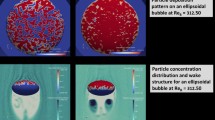Abstract
The authors study dynamics of heavy particle attached to the surface of free air bubble in liquid. The bubble with its surface vibrations and the particle are considered as a single mechanical system with geometric constraint. It is assumed that the main forces to govern interaction of these objects are the inertia force due to surface vibration of the bubble and the capillary adhesion force. The stability conditions of particle–bubble flotation aggregate at various initial surface vibrations of the bubble and at different masses of the particle are described. The velocities of the surface vibration modes are governed by the energy of turbulent pulsations in liquid.





Similar content being viewed by others
REFERENCES
Tabosa, E., Runge, K., and Duffy, K.A., Strategies for Increasing Coarse Particle Flotation in Conventional Flotation Cells,Proc. 6th Int. Flotation Conf., Cape Town, South Africa, 2013.
Goel, S. and Jameson, G.J., Detachment of Particles from Bubbles in an Agitated Vessel, Miner. Eng., 2012, vol. 36–38, pp. 324–330.
Nguyen, A.V., An-Vo, D.A., Tran-Cong, T., and Evans, G.M., A Review of Stochastic Description of the Turbulence Effect on Bubble–Particle Interactions in Flotation, Int. J. Miner. Proc., 2016, vol. 156, pp. 75–86.
Pyke, B., Fornasiero, D., and Ralston, J., Bubble–Particle Heterocoagulation under Turbulent Conditions, J. Colloid Interface Sci., 2003, vol. 265, pp. 141–151.
Nguyen, A., New Method and Equations for Determining Attachment Tenacity and Particle Size Limit in Flotation, Int. J. Miner. Proc., 2003, vol. 68, pp. 167–182.
Kondrat’ev, S.A. and Izotov, A.S., Influence of Bubble Oscillations on the Strength of Particle Adhesion, with an Accounting for the Physical and Chemical Conditions of Flotation, J. Min. Sci., 1998, vol. 34, no. 5, pp. 459–465.
Kondrat’ev, S.A. and Izotov, A.S., Interaction of a Gas–Liquid Phase Interface with a Mineral Particle, J. Min. Sci., 1999, vol. 35, no. 4, pp. 439–444.
Stevenson, P., Ata, S., and Evans, G.M., The Behavior of an Oscillating Particle Attached to a Gas-Liquid Surface, Ind. Eng. Chem. Res., 2009, vol. 48, pp. 8024–8029.
Rayleigh, L., On the Capillary Phenomena of Jets. Proc. R. Soc. London, 1879, vol. 29, pp. 71–97.
Deryagin, B.V., Theory of Distortions of the Plane Surface of a Liquid by Small Objects and its Application to Measurement of Edge Wetting Angles of Thin Films of Filaments and Fibers, Dokl. Akad. Nauk. SSSR, 1946, vol. 51, no. 7, pp. 517–520.
Tovbin, M.V., Chesha, I.I., and Dukhin, S.S., Investigation of Properties of Surface Layer of Liquids by the Floating Drop Method,Kolloid. Zh., 1970, vol. 32, no. 5, pp. 771–777.
Lanczos, C., The Variational Principles of Mechanics, University of Toronto Press, 1949.
Vejrazka, J., Vobecka, L., and Tihon, J., Linear Oscillations of a Supported Bubble or Drop, Phys. Fluids, 2013, vol. 25.
Snegirev, AYu., Vysokoproizvoditel’nye vychisleniya v tekhnicheskoi fizike. Chislennoe modelirovanie turbulentnykh techenii (High Performance Computing in Technical Physics. Numerical Modeling of Turbulent Flows), Saint Petersburg: Izd. Politekh Univ., 2009.
Liepe, F. and Mockel, H.O., Studies of Combination of Substances in Liquid-Phase 6, Influence of Turbulence on Mass-Transfer of Suspended Particles, Chem. Technol., 1976, vol. 28. pp. 205–209.
Andersson, R. and Andersson, B., On the Breakup of Fluid Particles in Turbulent Flows, Am. Inst. Chem. Eng. J., 2006, vol. 52, no. 6, pp. 2020–2030.
Schubert, H. and Bischofberger, C., On the Microprocesses Air Dispersion and Particle-Bubble Attachment in Flotation Machines as well as Consequences for the Scale-Up of Macroprocesses, Int. J. Miner. Proc., 1998, vol. 52, no. 4, pp. 245–259.
Schubert, H., Nanobubbles, Hydrophobic Effect, Heterocoagulation and Hydrodynamics in Flotation, Int. J. Miner. Proc., 2005, vol. 78, no. 1, pp. 11–21.
Rodrigues, W.J., Leal Filho, L.S., and Masini, E.A., Hydrodynamic Dimensionless Parameters and their Influence on Flotation Performance of Coarse Particles, Miner. Eng., 2001, vol. 14, no. 9, pp. 1047–1054.
Author information
Authors and Affiliations
Corresponding authors
Additional information
Translated from Fiziko-Tekhnicheskie Problemy Razrabotki Poleznykh Iskopaemykh, 2020, No. 6, pp. 125–135. https://doi.org/10.15372/FTPRPI20200611.
Rights and permissions
About this article
Cite this article
Kondrat’ev, S.A., Moshkin, N.P. PARTICLE–FREE AIR BUBBLE INTERACTION IN LIQUID. J Min Sci 56, 990–999 (2020). https://doi.org/10.1134/S1062739120060113
Received:
Published:
Issue Date:
DOI: https://doi.org/10.1134/S1062739120060113




